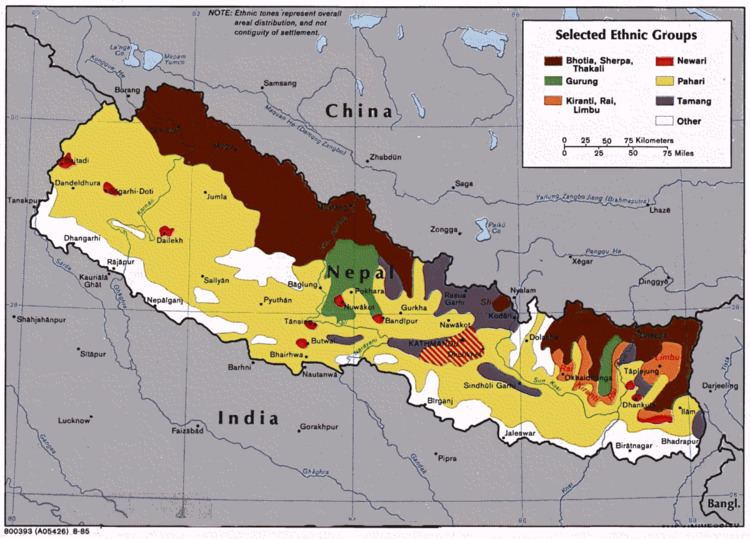 | ||
Nepal 16.6 per cent of total population (2011 census) India Indian Gorkha Populations in Sikkim, West Bengal, Uttarakhand, Himachal Pradesh and Assam. | ||
Chhetri (Chettri, or Chetri) (Hindi: छेत्री , Nepali: क्षेत्री), synonymous with Kshetri (Nepali: क्षेत्री) and Khatri (Nepali: खत्री) is a caste among Nepalese, Burmese Gurkhas, Indian Gorkhas and Lhotshampa Bhutanese peoples, which are a part of Khas people, along with some Brahmins (Bahun), and Thakuris. (Nepali: खस). Chhetris claim to be of the Kshatriya varna. They make up 16.6% of Nepal's population according to the census of 2011, making them the most populous caste or ethnic community in Nepal. The majority of Chhetris speak Nepali.
Contents
- History
- Society
- Religion
- Politics and Administration
- Literature Linguistics and Anthropology
- Media and Entertainment
- Sports
- References
Chhetris are primarily Hindu (99.48% according to the 2001 Census). Those Chhetri who follow Hinduism may also follow Buddhism. The ancient religion of the Chhetri is Masto which uses nature worship and can still be seen in western Nepal's Karnali district and in India's Gorkhaland. In Nepal's hill districts the Chhetri population rises to 41% compared to 31% Brahmin and 27% other castes. This greatly exceeds the Kshatriya portion in most regions with predominantly Hindu populations.
History
The origin of the Chhetris is uncertain. They were formerly known as Khas, but that term has now fallen into disuse. They are thought to be connected to the Khasas mentioned in the ancient Indian literature and the medieval Khasa kingdom.
The Chhetris first settled in Sinja Valley of Karnali in Nepal. The ancient name of this Himalayan region was Khas-des. Many Chhetris exhibit traits of mixed racial heritage, more so than Brahmins (also called Bahun in the Nepalese hills). There are several recognized ways to enter the Chhetri caste apart from Jharra (pure) Chettri:
- Having nothing but ancestors ultimately traceable to Kshatriyas.
- The child of a Chhetri father and a woman from lower but "clean" castes is still Chhetri.
- An arbitrary community can start following Chhetri caste rules (especially in diet), hiring Brahmin to conduct certain rituals and even writing dubious genealogy. Over generations these claims of Chhetri affinity become plausible to broader audiences.
In the early modern history of Nepal, Chhetris played a key role in the unification of the country, providing the core of the Gorkhali army of the mid-18th century. During the monarchy, Chhetris continued to dominate the ranks of the Nepalese Army, police, Nepalese government administration, and one regiment of the Indian Army.
Society
The most prominent feature of Nepalese Chhetri society has been the ruling Shah dynasty (1768–2008), the Rana Prime Ministers (1846–1953), Pandey (Clan of Kalu Pande),Thapa (Family of Bhimsen Thapa), Thapa Kings of Jumla, Khadka Kings of Gorkha, Basnet Kings of Khaptad, Family of Abhiman Singh Basnet, Malla Kings of Khas Desh,etc. that marginalized the monarchy, and the Chhetri presence in the armed forces, police, and Government of Nepal. In traditional and administrative professions, Chhetris were given favorable treatment by the royal government.
Religion
As per 2011 census, almost all Chhetris are Hindu. Chhetri religion began with shamanism and nature worship. The ancient religion of Khas people is Masto. When the Shakya Prince Siddartha Gautama achieved Nirvana and started preaching Buddhism in the 5th century BCE, Khas largely converted to Buddhism. The inhabitants of Khas later largely adopted Hinduism, however they revere and worship Buddha along with Hindu deities, and continue some shamanistic practices. The Chhetri people started following Hinduism around the 12th century, when Indian Hindus converted them into Hinduism. Today they still follow Buddhist gods along with Hindu, but their ancient Masto religion is now extinct.
